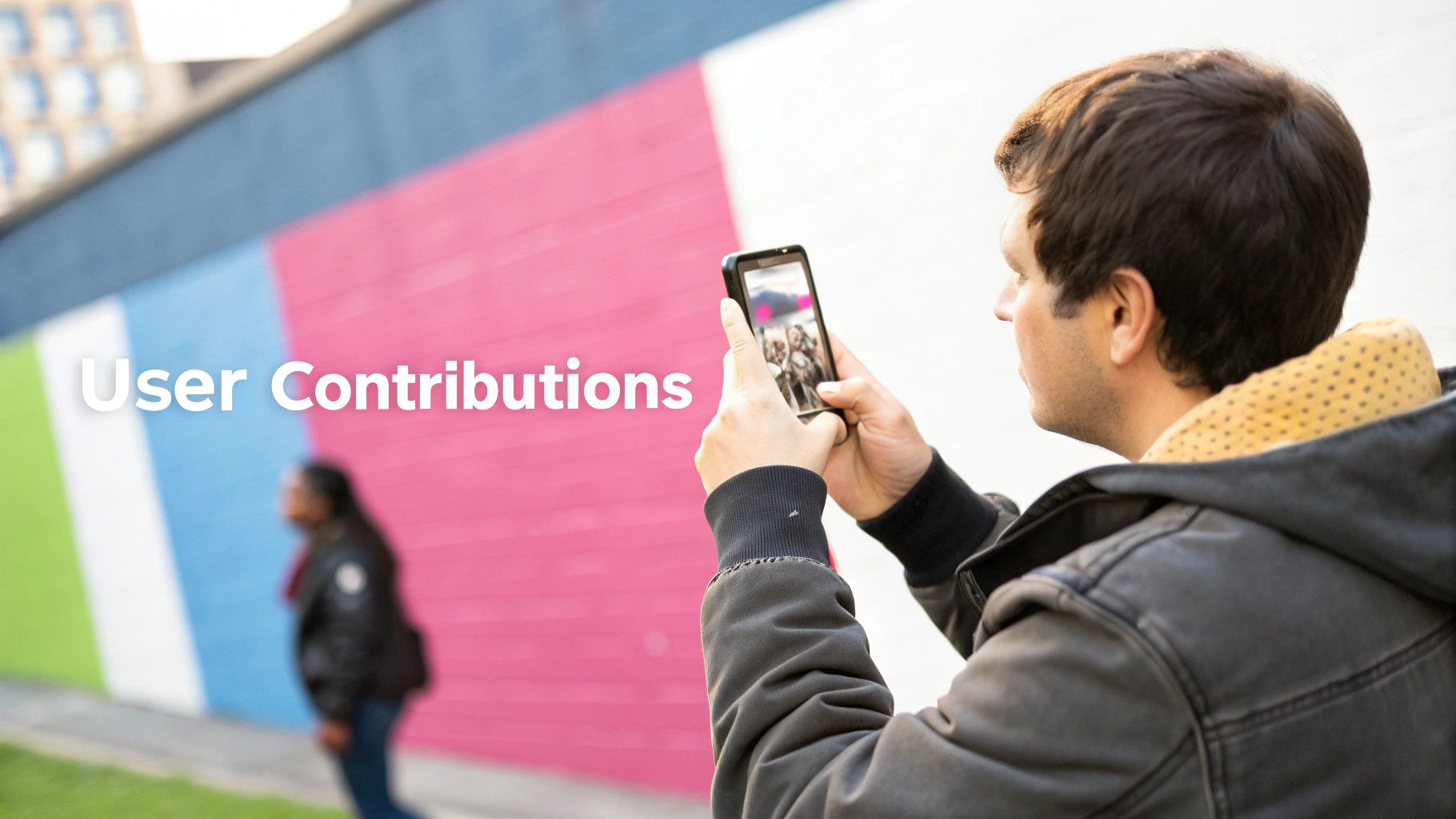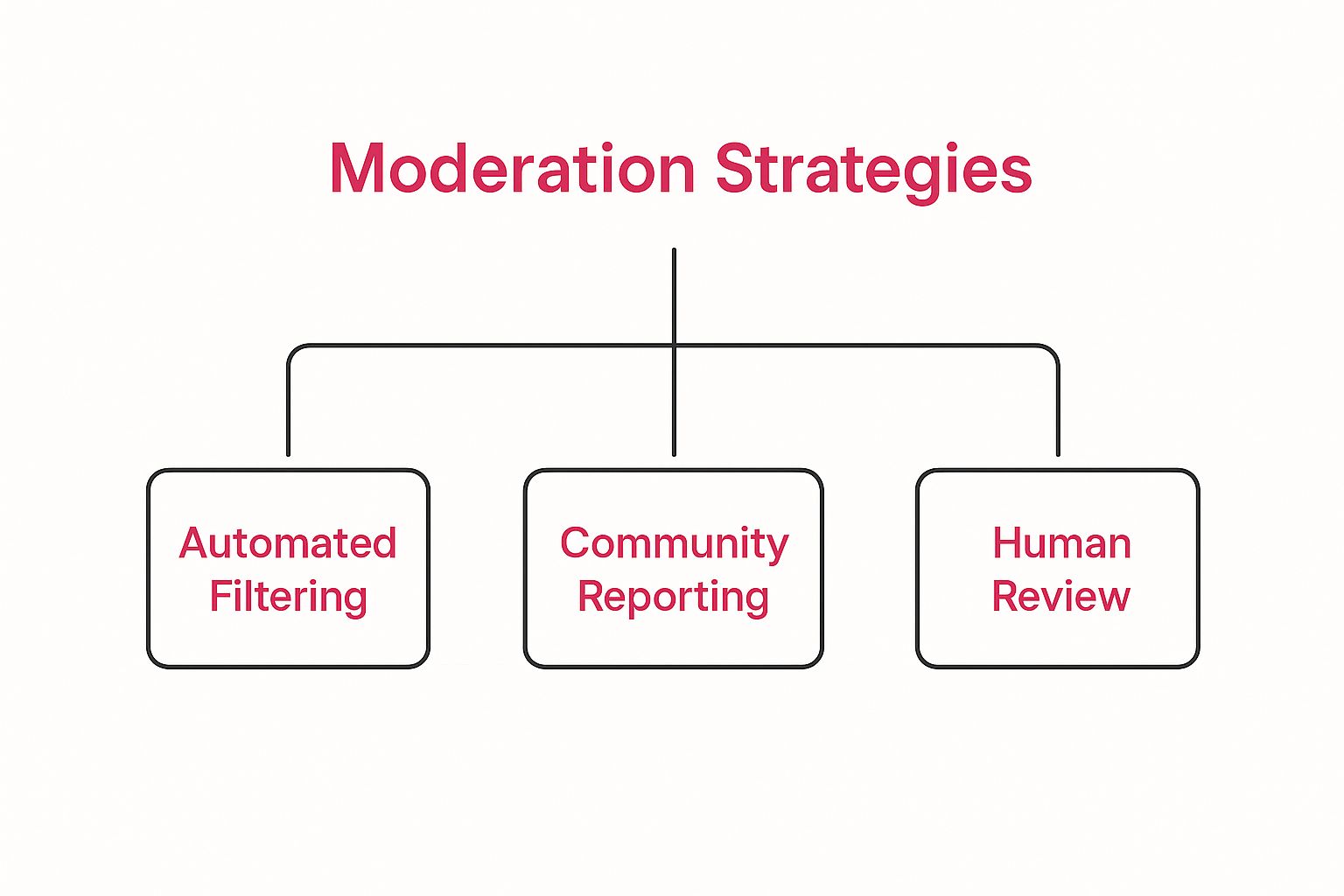Table of contents
Think of a bustling town square where your happiest customers are all sharing stories about your brand for everyone to see. That’s pretty much what a user generated content platform does in the digital world. It’s not just a simple photo gallery; it’s a smart system built to find, gather, and show off authentic content—like photos, videos, and reviews—made by real people.
From Customer Chatter to Brand Asset
At its heart, a user generated content platform is the bridge between your brand and the genuine content your customers are already creating. Picture it as an automated, clever curator that’s always scanning the internet for mentions of your brand, products, or campaign hashtags.
This kind of technology helps your marketing move beyond polished, company-made ads. Instead of you telling everyone how great your products are, a user generated content platform lets your actual customers do the talking. This builds a foundation of trust and social proof that traditional marketing often struggles to achieve.
The Power of Authentic Voices
In modern marketing, authenticity is everything. When potential buyers see real people genuinely enjoying a product, it hits home much harder than a staged photoshoot. These platforms are designed to plug directly into this powerful social dynamic. They centralise the entire process:
- Discovering Content: Automatically finding photos, videos, and posts where customers have tagged your brand or used a specific hashtag.
- Securing Permissions: Making the legal side of getting a creator's consent to use their content for marketing simple and straightforward.
- Organising and Curating: Giving you a central dashboard where you can filter, sort, and pick the most compelling content to feature.
- Showcasing Content: Seamlessly displaying these authentic visuals across your website, product pages, email newsletters, and even in your ad campaigns.
This shift is especially crucial in a hyper-connected market like Australia. As of early 2025, the country has around 20.9 million social media users—that's almost 78% of the entire population. These Aussies are active on an average of 6.5 different social platforms each month, which creates a massive pool of potential content. You can explore more about Australia's digital habits on DataReportal.com.
A user generated content platform turns passive audiences into active brand advocates. It takes all that organic enthusiasm from your customers and shapes it into a structured, scalable marketing asset.
When you bring customer voices into your marketing, you don't just get a cost-effective source of great content; you build a lively community around your brand. It shows you’re listening and that you value what your customers have to say, which builds deeper loyalty and encourages more people to share their own positive experiences. This cycle of sharing and recognition is what can turn a one-time buyer into a fan for life.
The Engine Behind a Powerful UGC Platform
 To really get why a user-generated content platform is so valuable, you have to pop the bonnet and see what makes it tick. Don’t think of it as a simple toolbox. It’s more like a sophisticated engine, purpose-built to power your entire content strategy.
To really get why a user-generated content platform is so valuable, you have to pop the bonnet and see what makes it tick. Don’t think of it as a simple toolbox. It’s more like a sophisticated engine, purpose-built to power your entire content strategy.
Every part of this engine has a specific, crucial job. Together, they turn random customer chatter into high-octane marketing fuel. This is what separates a dedicated user-generated content platform from just manually saving screenshots off Instagram. It automates the grunt work, putting you in control of a never-ending stream of authentic social proof that genuinely connects with people.
Let’s break down the four essential parts that keep this engine running smoothly.
Content Aggregation: The Smart Collector
First up, the most fundamental piece: content aggregation. This is the system that automatically scours the web for any and all content related to your brand. Think of it as having a team of digital scouts on the job 24/7.
These scouts are programmed to find content across all the important social channels—Instagram, TikTok, X (what used to be Twitter), you name it. They're looking for specific triggers you've set up, such as:
- Brand Mentions: Any post that tags your brand’s handle (like @YourBrand).
- Hashtag Campaigns: All the content using a specific campaign hashtag (e.g., #YourBrandStyle).
- Direct Uploads: Many platforms also give customers a way to submit content directly to you. This is gold for collecting detailed testimonials and reviews. To see this in action, check out how guest upload works—it's all about making it dead simple for users to share their stuff.
This constant collection means you always have a fresh, rich pool of potential marketing assets ready to go, without ever having to search for them yourself.
Curation and Moderation: The Command Centre
Once all that content is collected, it lands in your curation dashboard. This is your command centre. Here, you get to be the editor, hand-picking the content that best represents your brand.
A good platform doesn't just dump everything into one giant folder. It gives you powerful tools to sift through the noise and spot the real gems. You can filter posts by social network, media type, or even the sentiment of the caption. This is where you give the thumbs-up to content you want to use and ditch anything that’s off-brand, blurry, or just plain inappropriate.
It gives you 100% control over your brand's image, making sure only the very best customer stories get the spotlight.
Think of the curation dashboard as your quality control station. Nothing gets published or used in a marketing campaign without your explicit approval, protecting your brand's reputation at every step.
Rights Management: The Legal Handshake
This part is arguably the most critical. Using a customer's photo or video without asking is a huge legal and ethical no-no. A professional UGC platform completely solves this problem with built-in rights management tools.
The whole process is simple and automated. When you find a piece of content you absolutely love, the platform lets you send a rights request directly to the person who created it. They can grant permission with a quick reply, which creates a documented, legally sound agreement.
This "digital handshake" protects both your business and your customer. It ensures you have the proper legal standing to feature their content in your marketing. Managing testimonials and other UGC correctly is essential, and you can learn more about using testimonials in marketing to stay on the right side of best practices.
Display and Integration: The Showtime Tools
Okay, so you've found great content, curated it, and secured the rights. Now you need to show it off! This is where display and integration tools come in. They let you seamlessly embed all this authentic content across your digital real estate.
You can build beautiful, customisable galleries for your website, add compelling customer photos to your product pages to drive conversions, or even pull UGC into your email campaigns.
This is the final step that closes the loop, turning customer advocacy into a visible, impactful part of your business. By placing real customer content at key touchpoints, you build trust and provide the social proof that helps turn browsers into buyers.
How a UGC Platform Can Reshape Your Business Strategy

It’s one thing to understand the mechanics of a user generated content platform, but it’s another thing entirely to see how it can fundamentally reshape your approach to business. Let's move beyond the "what" and get into the "why it matters." At its core, embracing user-generated content (UGC) is about handing the microphone to your customers and letting their authentic voices drive your marketing results.
This isn’t just about collecting a few nice photos. It’s a strategic shift—moving away from brand-led monologues and towards customer-driven conversations. The end game? A more resilient, believable, and ultimately, more profitable brand.
To give you a clearer picture, here’s a breakdown of the key ways a UGC platform can directly benefit your business, turning customer content into tangible outcomes.
Key Benefits of Implementing a UGC Platform
These advantages work together to create a powerful flywheel effect, where authentic content fuels trust, which in turn drives sales and generates even more content. Let's dive a little deeper into each of these areas.
Building Unbreakable Trust and Social Proof
The single most powerful advantage of UGC is its almost magical ability to build unshakable trust. We live in a world saturated with slick, polished advertisements, and people have become naturally sceptical of what brands say about themselves. Content from real, everyday people cuts straight through that noise.
When a potential customer sees someone just like them using and loving your product, it acts as a powerful, unbiased endorsement. This is social proof in its purest form. Think of it as the digital equivalent of a friend recommending a great local cafe—it feels genuine, relatable, and is far more persuasive than any billboard could ever be.
A user generated content platform provides the system to collect and showcase this proof, turning your product pages, social media feeds, and ads into galleries of genuine customer happiness.
Driving Higher Conversions and Sales
That foundation of trust has a direct, measurable impact on your bottom line. Integrating UGC at critical points in the customer journey is a proven way to boost your conversion rates.
Just think about these scenarios:
- On Product Pages: A gallery of customer photos on a product page shows shoppers how an item looks and works in the real world. It answers their unasked questions and melts away any purchase hesitation.
- In Ad Campaigns: Ads that feature authentic UGC almost always outperform those with glossy, professional imagery. Why? Because they feel real and stop the scroll. They connect on a human level, making the call-to-action far more compelling.
- On Local Listings: To really stand out locally, customer reviews and photos on platforms like Google are gold. To take it a step further and attract more local customers, you need to optimize your Google My Business profile.
By showcasing happy customers, you’re giving that hesitant buyer the final nudge they need to click "add to cart." To explore this further, check out our guide on https://www.testimonialdonut.com/resources/10-creative-ways-to-use-testimonials-for-marketing.
By weaving customer stories into your marketing, you are not just selling a product; you are validating a buyer's decision before they even make it, creating a smoother path to purchase.
Creating a Cost-Effective Content Pipeline
Finally, a UGC platform gives you a scalable and incredibly cost-effective pipeline of marketing assets. For any marketing team, the constant grind of creating new photos, videos, and ad creative is a major drain on time and money.
A steady stream of high-quality UGC from your community eases this pressure immensely. Instead of brainstorming the next big campaign from scratch, you can tap into a constantly refreshing pool of authentic, ready-to-use content. This is especially true on platforms seeing explosive growth. For example, TikTok has become a dominant force in Australia, with about 8.5 million monthly active users—a massive opportunity for brands to tap into authentic video-first content.
This means your team can focus more on the big-picture strategy and less on the costly, repetitive cycle of content production. The result is stronger brand affinity and measurable, sustainable growth for your business.
Choosing the Right UGC Platform for Your Brand
With a whole sea of options out there, picking the right user generated content platform can feel like a massive task. But getting this choice right is absolutely critical if you want to turn your customers' authentic content into one of your most powerful marketing assets. The real goal is to find a system that doesn’t just solve today’s problems but can also grow alongside your brand.
Think of it like choosing a new vehicle for your business. A local tradie might just need a reliable ute for getting around town, while a national logistics company needs a full fleet of road trains. The best vehicle depends entirely on the job, and it's the exact same principle here. Your evaluation should be a practical, step-by-step look at what your brand actually needs.
Start With Your Content Sources
First things first, you have to ask: where do my customers actually live online? A platform is only as good as its ability to pull in content from the channels your audience loves and uses every day. If your customers are creating incredible video reviews on TikTok, a platform that only scrapes Instagram hashtags is completely useless to you.
Your ideal platform must connect with your community’s favourite channels. Before you even think about booking a demo, take a moment to map out where your best UGC is already coming from:
- Social Media: Are your people all over Instagram, TikTok, Facebook, or X? Make sure any platform you consider has solid, reliable integrations for these networks.
- Review Sites: Do you depend on reviews from Google, Yelp, or other industry-specific sites? Some platforms are smart enough to pull in these text-based testimonials and display them right alongside your visual content.
- Direct Uploads: Do you want customers to submit high-resolution photos or videos directly to you? This is vital for grabbing top-quality content that hasn't been squashed and compressed by social media algorithms.
By starting with your content sources, you immediately cut through the noise and narrow your search down to only the most relevant contenders.
Prioritise Customisation and Brand Alignment
Once you've got a steady stream of content flowing in, you need to display it in a way that feels like it truly belongs to your brand. A generic, clunky photo gallery that clashes with your website's design can do more harm than good, chipping away at the very trust you’re trying to build.
This is where customisation becomes a game-changer. The best user generated content platform will give you fine-grained control over the look and feel of your galleries and widgets. You should be able to tweak everything—colours, fonts, layouts, and call-to-action buttons—to perfectly match your brand’s unique style. The aim is for the UGC to feel seamlessly woven into your site, not like some third-party tool that’s been awkwardly bolted on.
When customer content is presented beautifully and cohesively, it elevates your brand's professionalism while amplifying the raw authenticity of the message. It sends a clear signal that you value both your brand's image and your customers' contributions.
This level of control is what ensures your brand feels consistent everywhere your customers interact with it, making their experience smooth, engaging, and trustworthy.
Focus on Moderation and Analytics
With a constant flow of new content coming in, you need powerful tools to manage it all. This is where moderation and analytics shift from "nice-to-have" to "non-negotiable" features. Moderation is your quality control; it’s the gatekeeper that ensures no inappropriate, low-quality, or off-brand content ever sees the light of day on your site.

As you can see, the most effective systems use a layered approach, blending smart automation with a final human review to give your brand the strongest possible protection.
Just as important are the platform's analytics. At the end of the day, you need to prove this is all worth it. A good platform will serve up clear, actionable data on key performance metrics, such as:
- Engagement: How many people are actually looking at and interacting with your UGC galleries?
- Click-Through Rate (CTR): Are they clicking on your call-to-action buttons?
- Conversion Rate: What percentage of users who engage with UGC go on to make a purchase?
These numbers are essential for showing the real-world value of your UGC strategy to the higher-ups and for fine-tuning your campaigns for even better results.
To help you compare what's on offer, here’s a quick breakdown of typical features you'll find.
UGC Platform Feature Comparison
When you're shopping around, it's easy to get lost in the jargon. This table breaks down what you can generally expect from different tiers of platforms, helping you match features to your specific business goals.
Thinking through these categories will give you a solid framework for asking the right questions during a sales demo and ensuring you pick a solution that truly fits.
Plan for Scalability and Growth
Finally, think about where your brand is headed. The platform that's perfect for you today should also be able to support you in two, or even five, years' time. Scalability is all about making sure the platform can keep up with your success, whether that means handling a much larger volume of content, expanding into new countries, or needing more sophisticated enterprise-level features.
Look at things like pricing models, access to an API for custom integrations, and the ability to manage multiple brands or regions from a single dashboard. Choosing a platform that can scale with you from the start saves you the massive headache and expense of having to switch systems down the road. To dive deeper into evaluating your choices, our comprehensive guide to user generated content platforms offers even more detailed comparisons.
By carefully working through these four key areas—content sources, customisation, management tools, and scalability—you can confidently pick a platform that will become a true cornerstone of your marketing, driving trust, engagement, and growth for years to come.
Launching Your First Successful UGC Campaign
So, you're ready to launch your first user-generated content campaign. This is the exciting part—where all the strategy and planning finally come to life. It’s the moment you stop talking about building a community and actually start building it, one piece of content at a time.
A successful launch isn’t just a roll of the dice; it’s the result of a smart, repeatable playbook. This process turns the idea of a user generated content platform from a buzzword into a real engine for your business. Let's walk through the essential steps to get it right, not just this first time, but every time.
Set Clear and Measurable Goals
Before you even think about asking for a single photo or video, you need to decide what a "win" looks like for your brand. Without clear goals, your campaign is just a ship without a rudder, and you'll have no way to prove its value later on.
Start by asking yourself what you really want to achieve. Are you trying to:
- Boost Conversion Rates? Maybe your goal is to lift sales on a specific product page by 15% after adding a gallery of customer photos.
- Increase Social Engagement? You could aim for 200 submissions for a new hashtag campaign in the first month.
- Build a Content Library? Perhaps the goal is to collect 50 high-quality, approved customer photos for your next round of ads.
When you have clear key performance indicators (KPIs) from the get-go, tracking your progress and proving the return on investment (ROI) becomes simple. It’s the difference between a hopeful experiment and a strategic business move.
Create Irresistible Incentives for Submission
Once you know what you’re aiming for, you need to give your audience a good reason to join in. Sure, some of your most loyal fans will share content just for the love of the brand, but the right incentives can get everyone else off the sidelines.
And it's not always about discounts. Think about what your audience truly values and get creative:
- Run a Contest: A big prize—like a year's supply of your product or a juicy gift card—can create a ton of buzz and a clear call to action.
- Offer Exclusive Access: Give participants a sneak peek at a new product or an invitation to a special online event. This makes them feel like insiders.
- Feature Them Publicly: Never underestimate the power of the spotlight. The chance to be featured on your brand’s official website or social media is often a huge motivator all on its own.
The best incentives aren't always the priciest. They're the ones that connect with your audience's passions and make them feel seen, appreciated, and part of your brand's story.
Promote Your Campaign Everywhere
You could have the most brilliant goals and the most amazing prizes, but if nobody knows your campaign exists, it’s doomed to fail. Promotion isn't the final step; it’s something you need to be doing all along. You have to get the word out on every channel your customers hang out on.
Map out a simple multi-channel promotion plan:
- Announce on Social Media: Design eye-catching posts for Instagram, Facebook, and TikTok that clearly explain the campaign, the rules, and the hashtag. Use features like Instagram Stories with countdown stickers to build excitement.
- Use Email Marketing: Send a dedicated email to your subscriber list. This is your chance to go into more detail and provide a direct link for submissions or more info.
- Website Banners: Put a can't-miss banner on your homepage or key product pages to grab the attention of anyone visiting your site.
- In-Store Signage: If you have a physical shop, use simple signs or QR codes near the checkout to get people involved while they're already engaged with your brand.
Spreading the word consistently and across multiple channels is how you make sure you reach the widest possible audience, which directly increases your chances of getting a flood of high-quality submissions.
Monitor, Analyse, and Optimise
Your job isn’t over once the campaign goes live. In fact, this is where the real work begins. You need to be actively watching your performance, digging into the data, and using what you learn to make things better. This is where the analytics inside your user generated content platform become your best friend.
Keep a close eye on the KPIs you set from the start. Are you hitting your submission targets? How’s the engagement on your social posts? More importantly, what is the content itself telling you? Are certain themes or photo styles getting way more love than others?
Use that data to make adjustments on the fly. If one channel is falling flat, shift your promotional energy elsewhere. If a particular type of content is a massive hit, give it a bigger platform. This constant loop of launching, listening, and tweaking is what turns a one-off win into a sustainable UGC strategy that delivers results again and again.
Common Questions About UGC Platforms
 Diving into the world of user-generated content is exciting, but it’s natural to have a few questions. We often hear brands getting curious about the practical side of things—the legalities, quality control, and the real-world process of actually getting started. This section tackles the most common concerns we come across, giving you clear, direct answers so you can move forward with confidence.
Diving into the world of user-generated content is exciting, but it’s natural to have a few questions. We often hear brands getting curious about the practical side of things—the legalities, quality control, and the real-world process of actually getting started. This section tackles the most common concerns we come across, giving you clear, direct answers so you can move forward with confidence.
Our goal here is to demystify the process and show you exactly how a user generated content platform is designed to handle these very challenges. Think of this as your go-to FAQ, built to clear up any lingering doubts.
How Do I Get Legal Permission to Use Customer Content?
This is one of the most critical questions, and the answer is probably simpler than you think. Good platforms have built-in rights management tools designed specifically to handle this. You never have to worry about manually tracking down permissions or navigating tricky legal grey areas.
When you spot a piece of content you love, the platform lets you send a permission request directly to the creator through their social media account. The creator can then grant consent with a simple, trackable action—often by just replying with a specific hashtag like #YesYourBrand.
This process creates a clear, documented, and legally sound agreement that protects your business. It's a non-negotiable step: never use customer content for commercial marketing without getting this explicit permission first.
What Happens If We Get Negative or Inappropriate Content?
This is a totally valid concern for any brand that cares about its public image. The good news is that a quality user generated content platform gives you complete control, acting as a powerful gatekeeper for your brand. Nothing goes live on your website or gets pushed into a marketing campaign without your team's say-so.
These platforms come equipped with robust moderation dashboards and filtering tools. Here’s a quick look at how they work:
- Automated Filtering: You can set up rules to automatically block or flag content containing certain keywords, profanity, or anything else you decide is off-brand.
- Manual Approval Queue: Every single piece of content pulled in by the platform lands in a moderation queue. This is where your team can manually review each submission, giving it a final thumbs-up or rejecting it.
This two-step process ensures that only the highest quality, on-brand content makes it through. It gives you full command over your brand’s narrative.
Think of your platform's moderation dashboard as your personal brand security team. It works around the clock to ensure that only the content that truly represents your brand's values ever sees the light of day.
How Can a Small Business Encourage UGC Submissions?
You absolutely do not need a massive following or a giant marketing budget to get the ball rolling with user-generated content. For small businesses, the key is to start with the loyal customers you already have. Your most passionate advocates are your biggest asset.
Begin by reaching out to them personally. A simple email asking them to share their experience can work wonders. From there, you can build momentum with a few simple tactics that deliver big results.
- Run a Small, Targeted Contest: Offer a prize that your specific audience would genuinely value. It doesn't have to be expensive; it just has to be desirable to them.
- Make Your Hashtag Obvious: Pick a submission hashtag that’s clear, short, and easy to remember. Promote it everywhere—in your email signature, on your receipts, and across your social profiles.
- Celebrate Every Submission: This is the most important step. Celebrate every single piece of content you receive. Feature it prominently on your website or social media. When people see you genuinely value their contributions, more will be eager to join in.
This creates a positive feedback loop where recognition encourages more sharing, building a vibrant community around your brand.
What Metrics Should I Track to Measure UGC Success?
To prove your efforts are paying off and secure ongoing support for your strategy, you need to track the right metrics. Measuring the success of UGC isn't just about counting likes; it's about connecting content to real business outcomes.
Focus on a few key areas to get a clear picture of your return on investment (ROI). Your user generated content platform should provide analytics that help you monitor:
- Engagement Metrics: This is your top-of-funnel data. Track the basics like likes, comments, and shares, but also pay close attention to the total number of approved submissions you receive.
- Conversion Metrics: This is where you see the real impact. Monitor the click-through rate (CTR) on your UGC galleries and, most importantly, the conversion rate of shoppers who interact with them. Many platforms can even attribute sales directly back to specific pieces of UGC.
- Content Cost Savings: This is a powerful metric to share with your higher-ups. Calculate the cost of your platform subscription and compare it to what it would have cost to produce that same volume of content with a professional creative team.
By tracking these key performance indicators, you can clearly demonstrate how UGC is not just building your brand, but also directly contributing to your bottom line.
Ready to put your reviews on autopilot and transform happy customers into your most powerful marketing asset? Testimonial Donut makes it incredibly simple to collect, manage, and showcase authentic customer stories that build trust and drive sales. Start simplifying your testimonial process today.



